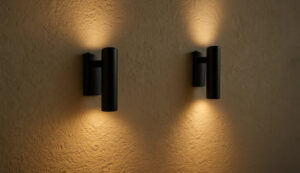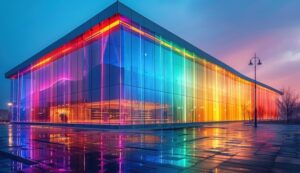In this article, we discuss the basics of low-voltage transformers and the key factors that will help you choose the right one for your business.
What is a Low Voltage Lighting System?
Low voltage lighting systems are a safer, more efficient solution to traditional lighting design. It uses LED (light emitting diode) technology at 12-24v DC power. The lower voltage results in less current running through the wires and reduced heat generation. In regards to safety, low voltage systems output less current, making them considerably safer.
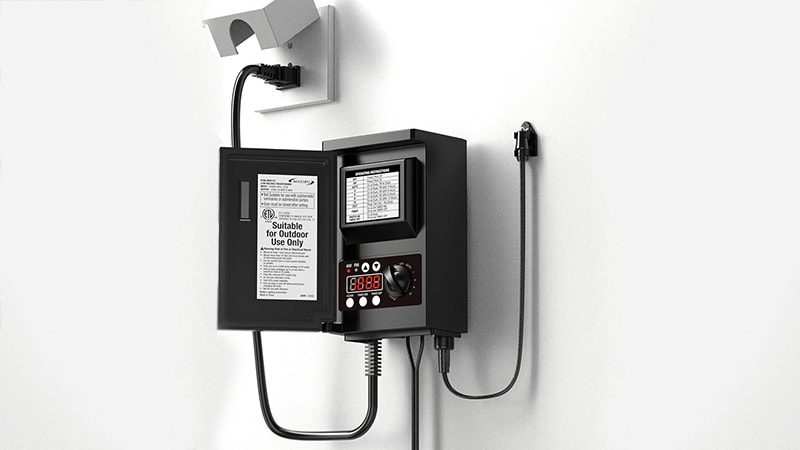
Traditional lighting solutions, like incandescent or halogen, run on 120-240v AC power. Modern LED lights with an E26 screw thread can accept 120v AC power. However, internal circuits convert the power into 12v DC before delivering it to the diodes.
What is a Low Voltage Transformer?
Low-voltage transformers are electrical devices that can take a 120v input and step it down to 12v. Many modern electronics, such as laptop adaptors, smartphone chargers, power tools, and kitchen appliances, have a built-in low-voltage transformer.
These devices don’t need 120 volts of power, so they convert it to a reasonable level for optimum operation. For example, laptop charging adaptors convert 120v wall power to ~19v.
Low-voltage transformers in lighting design are external units that pre-convert the voltage before supplying it to light fixtures. Thus, there is no need for smaller transformers attached to the LED lights.
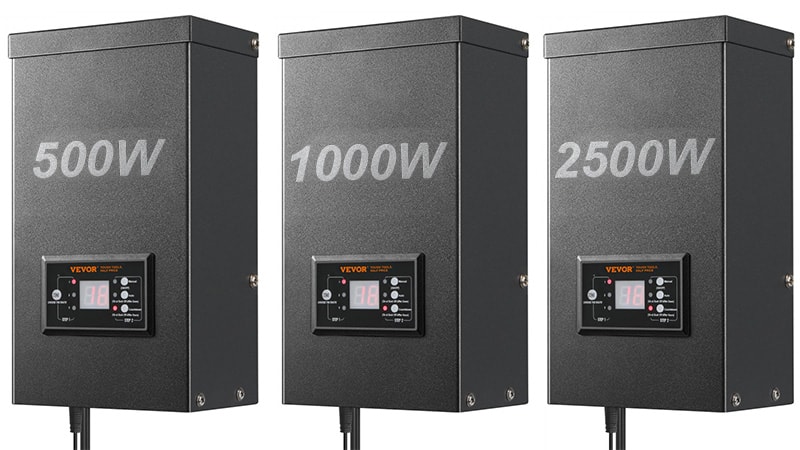
How to Choose a Low-Voltage Lighting Transformer?
Choosing a low-voltage transformer is all about assessing your current power requirements and planning for future expansion.
Step 1 – Calculating Wattage Requirements for Your Lighting
Wattage is the amount of electrical power a lighting fixture consumes for seamless operation. Higher wattage also means higher light output and greater room brightness. All commercial LED light fixtures have wattages written on the package or specification sheet (for bulk purchase from the supplier).
Calculating the total wattage is as easy as adding the individual wattage numbers on your light fixtures. Additionally, you want to account for the transformer’s safe continuous operation wattage. A 500W transformer can handle a peak power of 500W and a continuous power of 400W (80% of total capacity).
For example, Suppose a restaurant has ten 20W wall sconces for accent lighting, fifteen 30W pendant lights, and LED strips around the bar area that consume 25W.
- Total Wattage = Wall Sconce Wattage + Pendant Light Wattage + LED Strip Light Wattage
- Total Wattage = 10*20W + 15*30W + 25W
- Total Wattage = 675W
- Transformer Watts = 1.25*Total Watts
- Transformer Watts = 843.75W
So, this restaurant will need an 850W transformer to power all of its existing lighting.
Step 2 – Assess Voltage and Amps for Your Low Voltage Transformer
Understanding the relationship between wattage, voltage, and current (amps) can be tricky. So here is a quick visualization to help you master this electrical concept.
You can think of voltage as a pipe, current as flowing water, and wattage as the total volume of water that exits the pipe. The only way to increase the water output is to increase the pipe diameter or the water pressure (flow rate).

- Ohm’s Law States – Power = Current x Electrical Potential (W=A*V)
- Electrical Power is measured in Watts (Wattage)
- Electrical Potential is measured in Volts (Voltage)
- Electrical Current is measured in Amps (Amperage)
Similarly, you can get your desired wattage by either increasing the voltage or the current flow. Transformers will only accept a certain amount of amps at given voltages. A standard 5000w low-voltage transformer’s capacity will either accept 40A at 120v or 20A at 240v.
North America uses the 120v standard. This means your electrical distribution box will need a 40A circuit breaker to maintain the input power.
Next, check the operating voltage (12v/24v) of all the light fixtures you wish to install. Your transformer needs to supply enough amps to ensure proper illumination.
Step 3 – Consider a Multi-Tap Low Voltage Transformer
A multi-tap transformer is a versatile tool with a variable output voltage. A standard multi-tap transformer has a 12v to 22v operating range, which means users can choose any voltage between 12 and 22 volts.
Multi-tap models are designed to compensate for voltage drop across long wire connections. Voltage drop means a 12v supply will slowly degrade as the wire runs increase. After 20-30 meters, the voltage supplied will be reduced to under 10v.
Using a multi-tap low-voltage transformer, you can set the output voltage to 14 volts. Then, the voltage will drop to ~12v at the end of the wire. You can learn more about voltage drop right here.
Step 4 – Magnetic vs. Electronic Low Voltage Transformers
All transformers increase or lower voltage using magnetic flux. However, an electronic transformer is a special type of low-voltage transformer that utilizes an inverter device to increase its efficiency while reducing its size.
- Magnetic transformers are larger, more durable, and last longer.
- Electronic transformers are smaller, lighter, and less expensive.
Your choice of transformer will depend on your space requirements. An indoor transformer location may necessitate a compact electronic transformer. Electronic transformers have only one redeeming quality: their size.
Hence, whenever applicable, businesses should always use magnetic transformers.
Step 5 – Assess Installation Requirements
Transformer location depends on your application and space allocation priority. For most businesses, indoor space is better used for other tasks, and outdoor spaces are ideal for housing electrical devices.
- A key benefit of keeping your transformer indoors is environmental and moisture protection. Any outdoor space will require waterproofing to protect the transformer from moisture, dust, rain, and other environmental elements.
- Outdoor transformers can be easily wall or stake-mounted. Businesses should prioritize locations that are less exposed to the elements.
Another factor to consider before installing your low-voltage transformer is wiring runs. Choose an appropriate wire gauge that can handle the necessary power draw. Also, ensure your wire runs are long enough to reach every light fixture with some cable slack. Finally, account for voltage drop as discussed above.
Check out this helpful chart or consult a professional electrician for more information on wire gauges.
Step 6 – Ensure Safety and Compliance
Transformers are powerful devices with lots of electrical currents flowing through their internals. Overheating, electrical shorts, and accidental damage are rare in modern transformers but are nonetheless highly dangerous.
Ensure your low-voltage transformers are certified by credible national or international authorities.
- US residents should look for a UL (Underwriters Laboratories) marking on the transformer.
- European residents should look for a CE (Conformité Européenne) marking on the transformer.
These certifications ensure the transformer is built to high safety, health, and environmental protection standards.
Warranty is another key indicator of product quality. Longer warranty periods show the manufacturer’s confidence in the quality and reliability of their product. Reputable manufacturers offer at least 3-5 years of warranty on their low-voltage transformers.
Step 7 – Consider Future Expansion and Compatibility
Low-voltage transformers are a big investment for any business. Even if the transformer cost is reasonable, the additional wiring, lighting fixtures, and installation costs can increase quickly. Hence, it is important to consider the future scalability of your lighting design.
For example, a resort may not have a vast landscape lighting system now, but it may want to invest in one in the future. So, getting a high-quality transformer now is better, with some wattage headroom.
Furthermore, if a business wishes to deploy 24v LED lighting fixtures alongside its old 12v ones, it will need a multi-tap transformer.
4 Benefits of Low Voltage Lighting Systems for Landscape Lighting
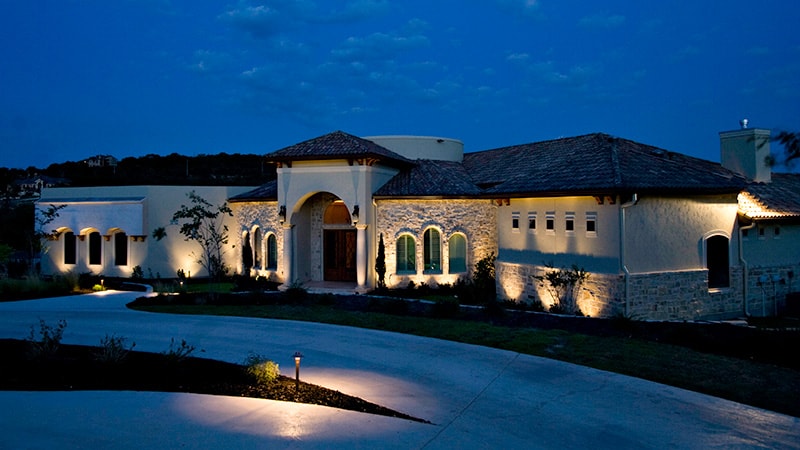
Low-voltage transformers are a great option for increasing energy efficiency and workplace safety. However, their true brilliance shines in landscape lighting systems.
The following is a short list of the biggest advantages of low-voltage landscape transformer installation.
1. Reduced Electrical Shocks & Fire Risks
landscape lighting systems use underground wiring. Over time, the electrical conduit will succumb to the environment and expose the wires to dirt and water. Wet dirt conducts electricity, increasing the chances of electrical shocks and fire.
Low-voltage landscape lighting uses one-tenth the voltage of incandescent lights, and the accompanying LED lighting fixtures require less current.
2. Design Flexibility and Installation
The best thing about using a low-voltage transformer is its versatility. It can power several light fixtures from a single source, reducing the need for internal transformers in fixtures.
You can install low-profile in-ground lights for your pathways, spike-mounted spotlights for foliage, and string lights for your backyard dining areas. All the light fixtures will run off a single low-voltage landscape transformer.
3. Energy Efficiency & Cost Savings
A landscape lighting system is expensive to run and maintain. Light coverage for a large area is always challenging. You need several light fixture designs to cover the various sections and run them at a high wattage to ensure adequate brightness.
Low-voltage transformers are a more efficient way of stepping down 120v wall power, and the matching LED fixtures use less power for the same brightness level. Less power consumption means lower electricity bills and more savings for the business.
Additionally, an LED light fixture has a longer lifespan than an incandescent one, reducing maintenance costs.
4. Outdoor Safety and Environmental Protection
Any outdoor lighting system will be at risk of environmental damage, especially during harsh weather conditions. Low-voltage transformers act as a hub for all the fixtures. Hence, operators can quickly shut down the transformer unit in case of an electrical shortage to prevent accidents.
Landscape lighting fixtures are also susceptible to damage. However, low-voltage lighting uses durable LED lights with polycarbonate casings, which makes them less likely to be damaged.
Conclusion
Low-voltage transformers are an incredible piece of modern technology. They efficiently convert the standard 120v wall power into safe and reliable 12v. What makes low-voltage transformers and even better deals is their companion, the humble LED light fixture. Choosing the right transformer for your application is all about wattage assessment. See how many watts your lighting design needs and get an appropriate transformer.
Transform Your Business with RC Lighting!
RC Lighting is the premiere LED lighting manufacturer in the industry. Over a decade of manufacturing experience has allowed us to perfect our craft and deliver high-quality Indoor and Outdoor Lighting products to the global market.
We use state-of-the-art equipment and employ the most talented engineers to stay up-to-date with technological advances.
Transform your business with the ultimate low-voltage lighting system from RC Lighting. Contact Us Now!

